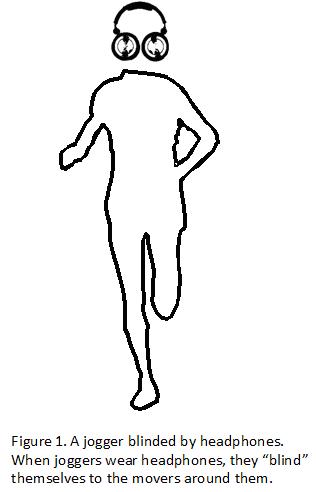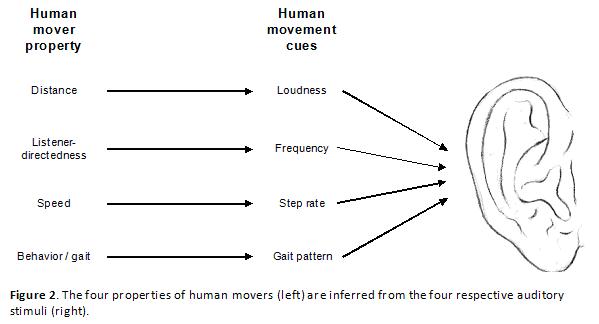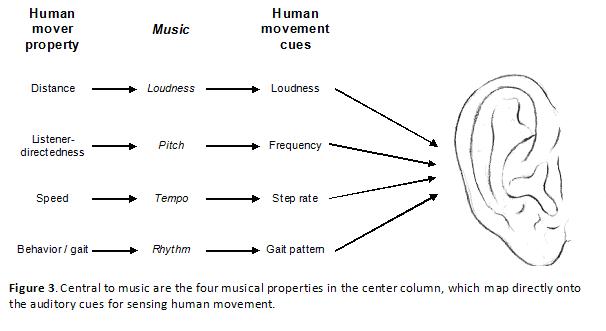Music-driven joggers may be experiencing a pleasurable diversion, but to the joggers and bikers in their vicinity, they’re Tasmanian Devils.
In choosing to jog to the beat of someone else’s drum rather than their own, headphoned joggers have blinded themselves to the sounds of the other movers around them. Headphones don’t prevent joggers from deftly navigating the trees, stumps, curbs, and parked cars of the world because these things can be seen as one approaches. But when one moves in a world with other movers, things not currently in front of you can quickly come to be in front of you. This is where the headphoned jogger stumbles … and crashes into the crossing jogger, passing biker, or first-time tricycler.
These music-filled movers may be a menace to our streets, but they can serve to educate us all about one of our underappreciated powers: using sound alone, we know where people are around us, and the nature of their movement. I’m sitting in a coffee shop as I write this, and when I close my eyes I sense the movement all around me: a clop of boots just passed to my right; a jingling-key person just walked in front of me from my right to my left, and back; and a pitter patter of a child just meandered way out in front of me. I sense where they are, their direction of motion, and their speed. I also sense their gait, such as whether they are walking or running. And I can often tell more than this, such as a brisk versus shuffling walk, an angry stomp versus a happy prance, or even a complex behavior, like turning and stopping to drop a dirty tray in a bin, slowing to open a door, or reversing direction to get a forgotten coffee. My auditory system carries out these mover-detection computations even when I’m not consciously attending to them. That’s why I’m difficult to sneak up on (although they keep trying!), and that’s why I only rarely find myself saying, “How long has that cheerleading squad been doing jumping jacks behind me?!” That almost never happens to me because my auditory system is keeping track of where people are and roughly what they’re doing, even when I’m otherwise occupied.
We can now see why joggers with their ears unencumbered by headphones almost never crash into feral dogs or runaway wheelchaired grandpas: they may not see the dog or grandpa, but they hear their movement through space, and can dynamically modulate their running to avoid both, and be merrily on their way. Without headphones, joggers are highly sensitive to the sounds of cars, and can track their movement: that car is coming around the bend; the one over there is reversing directly toward me; the one above me is falling; and so on. Headphoned joggers, on the other hand, have turned off their movement-detection system, and should be passed with caution! And although they are a hazard to pedestrians and cyclists, the people they put at greatest risk are themselves. This is because where there are joggers there are often cars nearby, and in collisions between a jogger and an automobile, automobiles typically only need a power-wash to the grill.

How does your auditory system serve as a movement tracking system? In addition to sensing whether a mover is to your left or right, in front or behind, and above or below – something that depends on the shape, position and number of ears you have – you possess specialized auditory software that interprets the sounds of movers and generates a good guess as to the mover’s movement through space. Your software has evolved to give you four kinds of information about a mover: (i) his distance from you, (ii) his directedness toward you, (iii) his speed, and (iv) his behavior or gait. How, then, does your auditory system infer these four kinds of information?
Evidence suggests that (i) distance is gleaned from loudness, (ii) directedness toward you can be cued by pitch (due to subtle but detectable Doppler shifts), (iii) speed is inferred by the number of footsteps per second, and (iv) behavior and gait are read from the pattern of footsteps. Four fundamental parameters of human movement, and four kinds of auditory cue: (i) loudness, (ii) sound frequency, (iii) step rate, and (iv) gait pattern.

Your auditory system has evolved to track these cues because of the supreme value in knowing where and what everyone is doing nearby.
This is where things get interesting… Even though joggers without headphones are not listening to music, their auditory systems are listening to fundamentally music-like constituents. Consider the four auditory movement cues mentioned just above (and shown on the right of Figure 2). Loudness? That’s just pianissimo versus piano versus forte and so on. Sound frequency? That’s roughly pitch. Step rate? That’s tempo. And the gait pattern? That’s akin to rhythm and beat. The four fundamental auditory cues for movement are, then, awefully similar to (i) loudness, (ii) pitch, (iii) tempo, and (iv) rhythm.

These are the most fundamental ingredients of music, and yet, there they are in the sounds of human movers. The most informative sounds of human movers are the fundamental building blocks of music!
The importance of loudness, pitch, tempo and rhythm to both music and movement is, I believe, more than a coincidence. The similarity runs deep – something speculated on ever since the Greeks. Research in my lab has been providing evidence that music is built not just with the building blocks of movement, but is actually organized like movement, thereby harnessing our movement-recognition auditory mechanisms. The story this leads to for music is this: Music has been culturally selected to sound like people moving, just the kinds of sounds your auditory system evolved to be great at processing. …and just the kinds of sounds that can possess emotional content that makes music evocative and worth listening to.
Music is evocative because it is made with people, something I also wrote about here [ http://bit.ly/rcKVh ], and something I will discuss further in the future.
Headphoned joggers, then, aren’t merely missing out on the real movement around them – they pipe into their ears a fictional movement, making them even more hazardous than a jogger wearing earplugs.





Comments